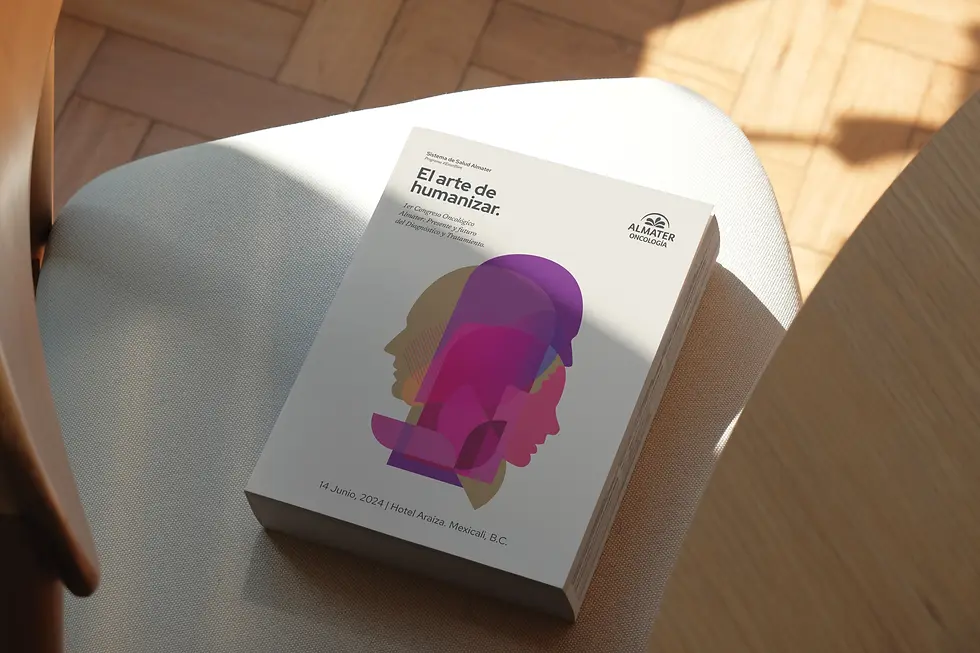
Almater Oncology Congress
Transforming Cancer Care Through Education and Collaboration
To elevate the Almater Oncology Center's profile among doctors and health personnel, we developed a comprehensive Logical Model of Health Literacy. This initiative aims to democratize the cancer continuum through education, forming a collaborative teaching bridge that helps dispel misconceptions about cancer before, during, and after diagnosis. The Almater Healthcare System has led this endeavor by collaboratively designing the 1st Almater Oncology Congress, themed “The Art of Humanizing.”
A Fellowship Journey Led by: Empathetic Discovery | Inclusive Strategy | Welcoming Design | Visual Storytelling | Illustration

How might we craft a flexible, inclusive identity for a collaborative initiative that destigmatizes cancer and fosters a more empathetic approach to care?
Through active listening and co-creation with the Almater health system, we developed a comprehensive Logical Model of Health Literacy. This model became the foundation for the 1st Almater Oncology Congress, themed "The Art of Humanizing."
We designed the congress around five key pillars:
Central to our approach was weaving a narrative of cross-functional collaboration throughout the congress identity, content, and positioning.
1. Decoding Cancer and Treatment Modalities
2. Pioneering Advanced Treatment Techniques
3. Empowering Early Detection and Prevention
4. Nurturing Coping Strategies
5. Catalyzing Patient Empowerment and Community Engagement
The congress transcended its educational mission, becoming a catalyst for strategic alliances within the Almater Healthcare System. These partnerships shape future initiatives, ensuring services align with community needs by fostering a person-centered culture and lifelong learning commitment.
1. Educational Brand Architecture
- Reimagine your brand as an educational platform that elevates industry knowledge.
- Design flexible learning experiences that adapt to various stakeholder needs.
2. Empathy-Driven Identity Design
- Craft a visual and verbal identity that embodies the human aspect of your services.
- Use design elements that convey warmth, understanding, and accessibility.
3. Thematic Pillars for Complex Topics
- Structure initiatives around clear, focused themes to make complex subjects more approachable.
- Design each pillar to resonate with your stakeholders' needs.
4. Collaborative Learning Ecosystem
- Foster cross-functional collaboration in your event design to break down silos.
- Create spaces for unexpected connections and knowledge exchange.
5. Strategic Alliance by Design
- Use educational initiatives as catalysts for forming meaningful partnerships.
- Design your events with built-in opportunities for alliance-building.
6. Humanity-Centered Service Innovation
- Align your services with evolving customer needs through continuous feedback loops.
- Design service touch points that prioritize empathy and personal connection.
7. Lifelong Learning Culture
- Embed a culture of continuous learning into your organizational DNA.
- Design internal systems that reward curiosity and knowledge-sharing.
8. Accessibility by Design
- Reimagine how your services can become more inclusive and accessible.
- Design multiple entry points for engagement, catering to diverse needs and abilities.
9. Humanizing Professional Practices
- Infuse empathy and human connection into professional protocols and practices.
- Design training programs that balance technical skills with emotional intelligence.
9. Accessibility-First Design
- Reimagine service delivery to reach underserved populations.
- Design flexible care models that adapt to diverse geographical and socioeconomic contexts.
10. Impact Measurement Design
- Create comprehensive systems to capture both quantitative and qualitative impact.
- Design feedback loops that inform continuous service improvement.
This model has the potential to inspire industries beyond healthcare. It showcases how education, collaboration, and human-centered design can transform services, build stronger communities, and create meaningful brand experiences. The approach changes medical education from a one-way transmission of knowledge into a collaborative, empathy-driven ecosystem that benefits professionals, patients, and the broader community.



